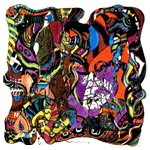This weekend I had the pleasure of seeing Spike Jonez’s film adaptation of Maurice Sendak’s children story “Where the Wild Things Are.” The film did a fantastic job of reminding me of the simpler times of being a pre-adolescent child – digging igloos in the snow, turning pieces of furniture into forts with blankets, and using imagination to take oneself away from the world around them. It got me thinking about the ways we replace these creative outlets of escapism once talking to fences and chasing dogs in animal costumes becomes socially unacceptable. Some people use hobbies, such as working on a car or engulfing oneself in a book, to get away from the hectic world around them. Others will resort to alcohol or drugs to escape. For me, nothing does a better job of clearing my mind and taking me away from everything than listening to music. Once I put my oversized Seinheiser headphones over my ears, press play, and the music begins to play, I feel just like Max felt when playing in the magical world with the Wild Things.
The first album that came to mind when I was pondering this was Spiritualized’s 1997 album – “Ladies and Gentlemen, We’re Floating In Space.” Starting with Kate Radley’s opening pronouncement of “Ladies and Gentlemen, We’re Floating in Space” and ending with the chaotic combination of distortion and horns on “Cop Shoot Cop,” the album’s powerful blend of rock, blues, gospel, free jazz, and punk influences takes the listener on a musical journey. This kaleidoscope of musical styles, paired with Jason Pierce’s hypnotic vocals, allows the listener lose themselves in the complex production of each song – whether it be the haunting melancholy of the strings on “Broken Heart” or the breakneck speed which the drums and fuzz and distortion drenched guitar hits a listener on “Electricity.”
Spiritualized is celebrating the 12th year anniversary of the release of “Ladies and Gentlemen…” (I know, who celebrates a 12th year anniversary?) with a series of shows in which the band performs the album in its entirety, from start to finish. The first performances were on Oct. 12th and 13th at London’s Royal Festival Hall. From the reviews written, these shows were an artistic success, but you can be the judge of it yourself – I have included a link to a blog which has posted the October 12th performance for download. The band will perform the album four additional times in December.
For those of us who don’t have the luxury of witnessing these performances, there is a consolation prize. There will be an expanded re-issue of “Ladies and Gentlemen…” on November 16th. The album will be available in three different formats – a single CD (which replaces the opening track most have known with the original version of the song “Ladies and Gentlemen We’re Floating In Space” which includes lyrics from “I Can’t Help Falling In Love,” as the band originally intended), a 3-disc set (which includes two full discs of demos and alternate versions ), and also a collectors edition, which will have each of the 12 songs on individual 3” discs, in a pill package design, as well as the 2 bonus discs.
I cannot recommend this album highly enough. It is one of the best albums of our generation, and a much more socially acceptable way for adults to escape than dressing in a full-body cat suit and chasing the family dog (but equally enjoyable). Do you have a favorite album that takes you away? Share yours in the comment section!




